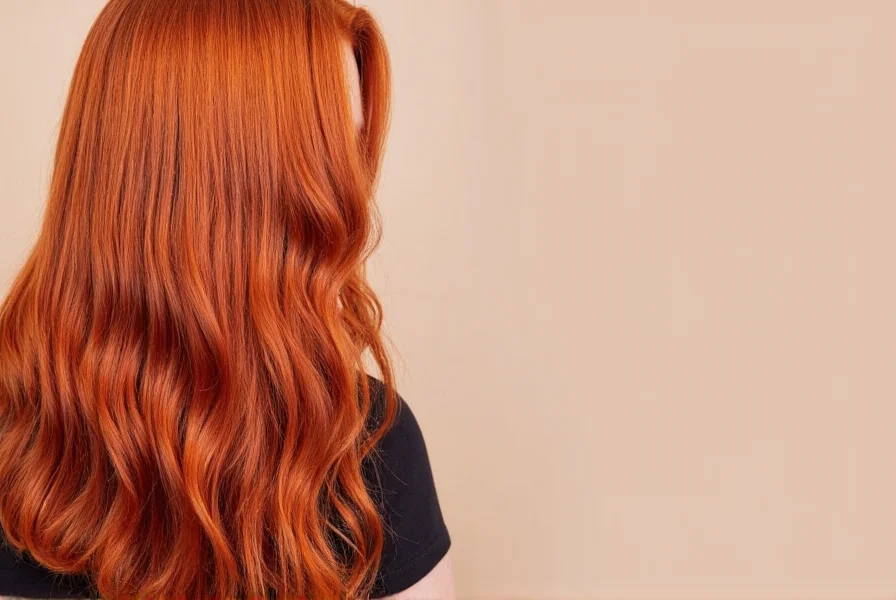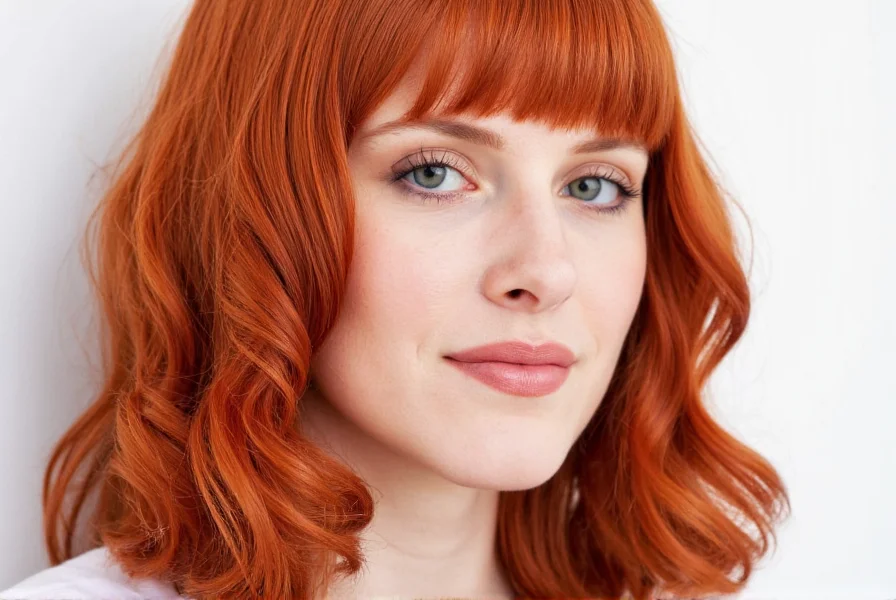Ginger hair represents one of the most distinctive hair color categories, celebrated for its warm, fiery appearance that ranges from pale strawberry blonde to intense copper-red. Unlike other red hair variations, genuine ginger tones maintain a consistent orange-red base without significant brown or violet undertones that characterize auburn or burgundy shades.
Understanding Ginger Hair Color Spectrum
The ginger hair color spectrum encompasses several distinct variations, each with unique characteristics that appeal to different complexions and personal styles. Professional colorists typically categorize ginger shades along a continuum from light to dark:
| Ginger Shade | Characteristics | Best For Skin Tones |
|---|---|---|
| Light Ginger | Pale orange with golden highlights, often with natural freckles | Cool fair skin with pink undertones |
| Middle Ginger | Balanced orange-red, most common natural ginger shade | Warm fair to medium skin |
| Dark Ginger | Deep copper with subtle red flashes, less orange appearance | Medium to olive complexions |
| Fiery Ginger | Bright, intense orange-red with maximum vibrancy | Warm undertones with contrasting eye color |
Ginger vs. Other Red Hair Tones
Many people confuse ginger with other red hair variations, but key distinctions exist. Ginger hair maintains consistent orange undertones throughout, while auburn contains brown undertones creating a cooler, more subdued appearance. Copper hair leans toward metallic gold-red tones, and burgundy incorporates purple undertones for a cooler, deeper effect.
Understanding these differences proves essential when selecting hair color products or considering a color change. Professional color matching for ginger hair color correction requires acknowledging these subtle but significant variations in undertones.
Skin Tone Compatibility with Ginger Hair
Successful ginger hair color application depends significantly on matching the specific ginger shade to your skin's undertone. Contrary to popular belief, ginger isn't exclusively for pale complexions—certain darker ginger variations complement medium and olive skin tones beautifully.
Warm undertones generally pair best with ginger hair color, as the orange-red base creates harmony rather than contrast. Those with cool undertones can still achieve flattering results by selecting ginger shades with subtle golden or copper reflections that bridge the temperature difference.
For individuals considering professional ginger hair color services, consulting with a color specialist about your specific undertone and natural hair base prevents unwanted brassiness or color mismatch. The right ginger shade selection enhances natural features rather than competing with them.
Maintaining Vibrant Ginger Hair Color
Ginger hair color requires specialized care to maintain its vibrancy and prevent unwanted fading to brassy or dull tones. The orange-red pigments in ginger hair color tend to fade faster than darker shades due to their molecular structure.
Professional colorists recommend these maintenance strategies for both natural and dyed ginger hair:
- Use sulfate-free, color-protecting shampoos specifically formulated for red hair
- Incorporate weekly color-depositing conditioners to refresh ginger tones
- Apply UV-protective hair products to prevent sun-induced fading
- Limit washing frequency to preserve color integrity
- Schedule regular gloss treatments to maintain shine and tone
For those experiencing ginger hair color fading toward unwanted orange or yellow tones, purple or blue-toned shampoos can help neutralize brassiness without altering the fundamental ginger character.

Genetic Basis of Natural Ginger Hair
Natural ginger hair results from a specific recessive variation in the MC1R gene on chromosome 16, which affects melanin production. This genetic mutation reduces eumelanin (brown-black pigment) while increasing pheomelanin (red-yellow pigment), creating the distinctive ginger appearance.
The MC1R gene variation occurs most frequently in populations with Celtic and Norse ancestry, explaining why ginger hair appears most commonly in Scotland, Ireland, and parts of England. Approximately 13% of Scotland's population has natural ginger hair, making it the global epicenter for this distinctive trait.
Interestingly, natural ginger hair often comes with associated characteristics including fair skin that burns easily, increased sensitivity to temperature changes, and a higher threshold for certain pain medications.
Common Ginger Hair Color Challenges
Individuals with ginger hair—whether natural or dyed—often face specific color maintenance challenges:
Fading and Brassiness: Ginger tones fade faster than darker colors, often shifting toward undesirable brassy or yellow tones. Regular toning treatments help maintain the desired orange-red balance.
Gray Coverage: Covering gray hair while maintaining true ginger tones presents unique challenges, as standard red dyes often turn muddy when mixed with gray strands. Specialized ginger-toned permanent dyes provide better results.
Color Correction: Changing from ginger to other colors requires careful planning, as the underlying orange pigments can affect subsequent color applications. Professional color correction typically involves multiple steps to neutralize orange tones before applying new color.

Cultural Significance of Ginger Hair
Ginger hair has held cultural significance across various societies throughout history. In ancient Egypt, red hair associated with the god Set carried both positive and negative connotations. During medieval Europe, ginger-haired individuals sometimes faced superstition and discrimination.
Modern perceptions have shifted significantly, with ginger hair now celebrated for its uniqueness. Contemporary celebrities like Emma Stone, Prince Harry, and Julianne Moore have helped normalize and celebrate ginger hair color in mainstream culture.
Understanding the historical context helps ginger-haired individuals appreciate their distinctive trait within a broader cultural framework, moving beyond outdated stereotypes to embrace the beauty of this relatively rare hair color.
Choosing the Right Ginger Shade for You
Selecting the perfect ginger hair color variation involves considering multiple factors beyond simple preference. Professional color matching assesses:
- Natural hair base color and current condition
- Skin undertones (warm, cool, or neutral)
- Eye color for complementary contrast
- Lifestyle factors including sun exposure
- Maintenance commitment level
For those experimenting with temporary ginger hair color, color-depositing conditioners offer a low-commitment way to test different ginger variations before committing to permanent color. Professional consultations with experienced colorists provide the most accurate assessment for achieving your ideal ginger hair color result.
Frequently Asked Questions About Ginger Hair Color
What's the difference between ginger and auburn hair color?
Ginger hair features prominent orange-red undertones throughout, creating a warm, vibrant appearance. Auburn hair contains brown undertones that create a cooler, more subdued reddish-brown shade. The key difference lies in the underlying tone—ginger maintains consistent orange warmth while auburn incorporates brown for a deeper, less fiery effect.
Does ginger hair color suit olive skin tones?
Yes, specific ginger variations complement olive skin tones beautifully. Darker ginger shades with copper undertones work particularly well, as they harmonize with olive complexions without creating harsh contrast. Avoid very bright, light ginger shades which may clash with olive undertones. Consulting with a professional colorist helps identify the precise ginger variation that enhances your natural coloring.
How often should I refresh my ginger hair color?
For optimal vibrancy, professional ginger hair color typically requires refreshing every 4-6 weeks. The orange-red pigments fade faster than darker colors due to their molecular structure. Using color-depositing conditioners between salon visits extends color longevity. Those with natural ginger hair may need gloss treatments every 3-4 weeks to maintain peak vibrancy and prevent brassiness.
Can I achieve ginger hair color without bleach?
Yes, many ginger hair color variations can be achieved without bleach, especially on light to medium natural bases. Darker hair typically requires some lightening to prevent muddy results, but professional colorists can often use color-removing techniques rather than full bleaching. For natural blondes or light browns, direct application of ginger tones frequently produces excellent results without pre-lightening.
Why does my ginger hair turn brassy after coloring?
Ginger hair turns brassy as the red pigments fade faster than the underlying orange tones, revealing unwanted yellow-orange undertones. This occurs due to the molecular structure of red dyes and exposure to environmental factors like sun, chlorine, and hard water. Regular use of blue or purple toning products counteracts brassiness by neutralizing yellow tones while preserving the desired ginger character.










 浙公网安备
33010002000092号
浙公网安备
33010002000092号 浙B2-20120091-4
浙B2-20120091-4